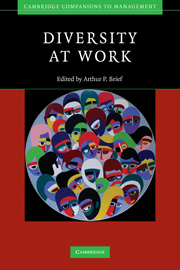Book contents
- Frontmatter
- Contents
- List of figures
- List of tables
- List of contributors
- Foreword
- Preface
- 1 Introduction: Where the sweet spot is: Studying diversity in organizations
- Part I Conceptual foundations
- 2 Stereotypes and prejudice create workplace discrimination
- 3 Promoting racial diversity at work: Challenges and solutions
- Part II Emerging theoretical approaches
- Part III Moving ahead: Agendas for practice and research
- Index
- References
3 - Promoting racial diversity at work: Challenges and solutions
Published online by Cambridge University Press: 19 May 2010
- Frontmatter
- Contents
- List of figures
- List of tables
- List of contributors
- Foreword
- Preface
- 1 Introduction: Where the sweet spot is: Studying diversity in organizations
- Part I Conceptual foundations
- 2 Stereotypes and prejudice create workplace discrimination
- 3 Promoting racial diversity at work: Challenges and solutions
- Part II Emerging theoretical approaches
- Part III Moving ahead: Agendas for practice and research
- Index
- References
Summary
From social stratification to workplace discrimination: Six decades of sociological inquiry
Studies of social class, social stratification, and social mobility – inquiries into how aspects of one's social origins facilitate or limit one's career success as an adult – have a long and distinguished history in American sociology, dating back to the 1940s (Davis and Moore, 1945; Warner, Meeker, and Bells, 1949; Gordon, 1949; 1958; Lipset and Bendix, 1959; Blau and Duncan, 1967). However, sociological scholarship on how workplace policies and practices limit or promote equal employment opportunity (“EEO”) is a relatively recent phenomenon, and the discipline all but ignored workplace racial bias prior to the 1970s.
It should be no surprise that American sociologists began to take notice of racial bias in employment around the same time as the rest of the country. The counts in Figure 3.1 are based on 80% or higher relevancy scores in a JSTOR search in the discipline's premier journals, American Sociological Review and American Journal of Sociology for the terms “race or racial” and “discrimination or bias” and “employment or jobs or careers” and “organization or firm or workplace.” Similar patterns to those in Figure 3.1 are evident when I include other journals or somewhat broader search terms. The civil rights and student movements, urban unrest, and landmark legislation of the 1960s motivated sociological inquiry in much the same way it shaped political discourse.
- Type
- Chapter
- Information
- Diversity at Work , pp. 53 - 86Publisher: Cambridge University PressPrint publication year: 2008
References
- 12
- Cited by



